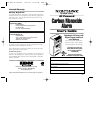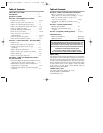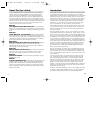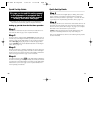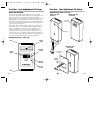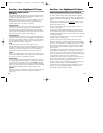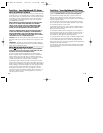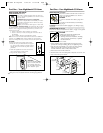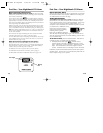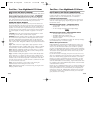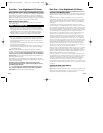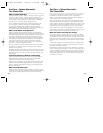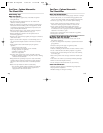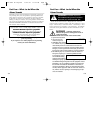
1-5
Part One – Your Nighthawk CO AlarmPart One – Your Nighthawk CO Alarm
Where to Install Your CO Alarm
Your Nighthawk CO alarm should be mounted in or near bedrooms
and living areas. It is recommended that you install a Nighthawk CO
alarm on each level of a multi-level home. You may use the number
and location of smoke alarms installed in your home according to
current building code requirements as a guide to the location of
your Nighthawk CO alarm(s).
WHEN CHOOSING YOUR INSTALLATION LOCATIONS, MAKE
SURE YOU CAN HEAR THE ALARM FROM ALL SLEEPING
AREAS. IF YOU INSTALL ONLY ONE CARBON MONOXIDE
ALARM IN YOUR HOME, INSTALL THE ALARM NEAR BED-
ROOMS, NOT IN THE BASEMENT OR FURNACE ROOM.
TWO SELF ADHESIVE LABELS ARE INCLUDED WITH THE CO
ALARM. ADD THE PHONE NUMBER OF YOUR EMERGENCY
SERVICE PROVIDER IN THE SPACE PROVIDED. PLACE ONE
LABEL NEXT TO THE ALARM AND ONE LABEL NEAR A FRESH
AIR SOURCE SUCH AS A DOOR OR WINDOW.
CAUTION: This CO alarm will only indicate the presence of carbon
monoxide at the sensor. Carbon monoxide may be present in other
areas.
IMPORTANT: Improper location can affect the sensitive electronic
components in this CO alarm. Please see the next section describing
where NOT to install this CO alarm.
If you must install a Nighthawk CO alarm near a cooking or heating
appliance, install AT LEAST 15 feet away from the appliance.
Do not install in excessively dusty, dirty or greasy areas such as
kitchens, garages and furnace rooms. Dust, grease or household
chemicals can contaminate or coat the CO alarm’s sensor, causing the
unit not to operate properly.
Do not obstruct the vents located at the top and bottom of the CO
alarm. Place the CO alarm where drapes, furniture or other objects
do not block the flow of air to the vents.
Do not install in dead air space, such as peaks of vaulted ceilings or
gabled roofs, where carbon monoxide may not reach the sensor in
time to provide early warning.
Do not install in turbulent air from ceiling fans. Do not install near
doors and windows that open to the outside, near fresh air vents, or
anywhere that is drafty. Rapid air circulation from fans or fresh air
from outside may affect the unit’s alarm response time.
Do not install this CO alarm in a switch- or dimmer-controlled outlet.
Do not install in areas where the temperature is colder than 40˚F
(4.4˚C) or hotter than 100˚F (37.8˚C). These areas include uncondi-
tioned crawl spaces, attics, porches and garages. Extreme temperatures
will affect the sensitivity of the alarm.
Do not install CO alarm near deep cell large batteries. Large batteries
have emissions that can cause the CO alarm to perform at less than
optimal performance.
Where Not
to Install Your CO Alarm
To avoid causing damage to the CO alarm, to provide optimum
protection, and to prevent unnecessary alarms, follow the direc-
tions below where NOT to install this CO alarm:
It is not recommended that you install this CO alarm in garages,
kitchens or furnace rooms. Installation in these areas could lead to
nuisance alarms, may expose the sensor to substances that could
damage or contaminate it, or the alarm may not be heard by persons
in other areas of the home, especially if they are sleeping.
In the garage, vehicle exhaust can contain some carbon monoxide.
These levels are higher when the engine is first started. CO levels in a
garage may not be sufficient to activate the alarm immediately. Within
hours of starting a vehicle and backing it out of the garage, the levels
present over time can activate the alarm and become a nuisance.
In the kitchen and furnace room, some gas appliances can emit a
short burst of carbon monoxide upon startup. This is normal. If your
CO alarm is mounted too close to these appliances, it may alarm
often and become a nuisance.
1-6
810-1009 AC Digital 11/13/01 11:22 AM Page 12



